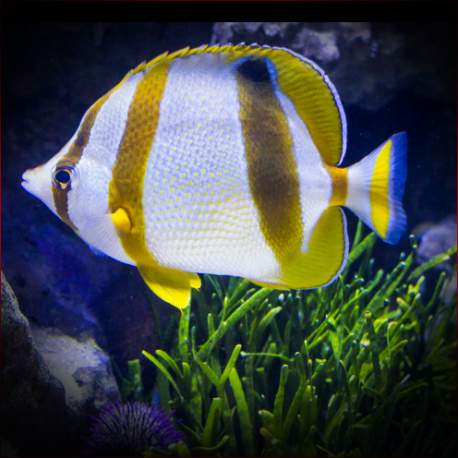More info
Datasheet
| Minimum Tank Size | 400 litres / 105.67 US gallons |
| Maximum Size | 20.0cm / 7.87inches |
| Reef Compatible | Reef safe with luck |
| Temperament | Mostly peaceful but might be aggressive towards similar species |
| Temperature | 22.2°C / 71.96°F - 25.6°C / 78.08°F |
| Specific Gravity | 1.020-1.025 |
| Carbonate Hardness | 8-12 |
| pH | 8.1-8.4 |
General Description: The Doublesash Butterflyfish, scientifically known as Chaetodon marleyi, belongs to the Chaetodontidae family, characterized by its attractive patterns and colors. These fish are often part of a species complex due to their striking resemblance, requiring careful identification as their needs can vary significantly, from color nuances to origin distinctions.
Aquarium Suitability: Considered suitable for special aquariums, these butterflyfish should be kept in a well-established tank with ample swimming space and hiding spots among live rocks. They thrive in temperatures between 18 to 21°C (64 to 70°F) and require a diverse diet that may include tubeworms, algae, microalgae, small crustaceans, and zooplankton.
Demands, Care, and Hardiness: With an average hardiness level, these fish demand a well-maintained aquarium where they can graze on algae-covered surfaces. They can coexist peacefully in pairs if introduced simultaneously and require regular feeding with live or frozen foods to simulate their natural diet adequately.
Reef Suitability: The Doublesash Butterflyfish is deemed reef-safe with luck, as it may nibble on clams, including Tridacna species, and necessitates a tank with sufficient soft and LPS corals to mimic their natural environment.
Aquarium Setup: When setting up an aquarium for these butterflyfish, it is crucial to maintain water parameters within specific ranges: a pH of 8.1-8.4, a specific gravity of 1.020-1.025, and a temperature range of 22.2-25.6°C (72-78°F). They require a tank size of at least 400 liters and should be housed with peaceful tank mates to avoid potential aggression.
Behaviour: Usually of a peaceful temperament, these fish may display aggressiveness towards similar species if not paired. Providing multiple hiding spots and ensuring a varied diet are key to promoting their well-being in an aquarium setting. Butterflyfish are known to largely ignore other tank inhabitants.
Feeding and Diet: The recommended diet for Doublesash Butterflyfish includes macroalgae, microalgae, small crustaceans like krill and mysis, and zooplankton. Supplementing their diet with live foods and nutritious algae-rich options such as Spirulina is vital to their health and vitality in captivity.
Habitat and Distribution: Found predominantly in the West Indian Ocean, these butterflyfish prefer cooler waters and typically reside in reef environments where they can feed on a variety of invertebrates, including tubeworms and bristleworms. Mimicking their natural habitat and diet plays a pivotal role in successfully keeping these fish in captivity.

